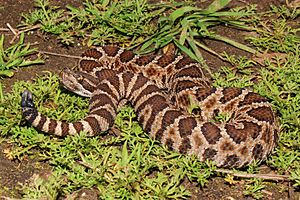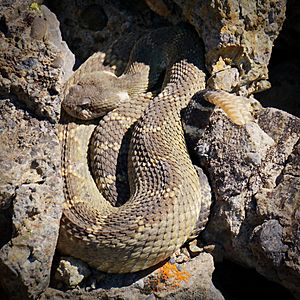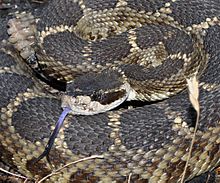Western rattlesnake facts for kids
Quick facts for kids Western rattlesnake |
|
|---|---|
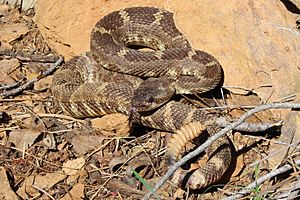 |
|
| Conservation status | |
| Scientific classification | |
| Genus: |
Crotalus
|
| Species: |
oreganus
|
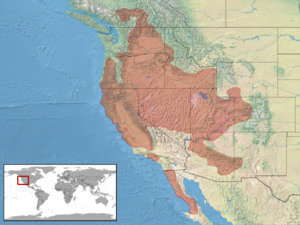 |
|
| Synonyms | |
|
|
The Western rattlesnake, also called the northern Pacific rattlesnake, is a type of venomous snake. It's a pit viper found in western North America. You can find it from the Baja California Peninsula all the way up to the southern part of British Columbia in Canada.
Contents
Discover the Western Rattlesnake
This snake's size can be very different depending on where it lives. Some Western rattlesnakes stay small, while others grow quite large. Many snakes on the mainland can reach about 100 cm (39 in) long. The longest one ever recorded was 162.6 cm (64.0 in).
Young rattlesnakes usually have clear patterns on their skin. But as they get older, these patterns often fade away. The color of their eyes often matches their body color. This can be bronze, gold, or different shades of tan, pink, or gray.
The most common type, C. o. oreganus, has a main body color that can be dark-brown, dark-gray, or olive-brown. Sometimes it's black or a pale yellowish color. On its back, it has large, dark blotches. These blotches have uneven white edges. They are also wider than the spaces between them.
There are also blotches on the sides of the snake. These are usually darker than the ones on its back. The first rings on its tail are similar to the last body blotches. But these rings get darker as they go down the tail. The last two rings at the base of the tail are usually black. The snake's belly is pale yellow, often with brown spots.
It has a large, dark-brown spot on its snout. Behind this spot is a pale border that forms bars above its eyes. A dark brown stripe goes from its eye to the corner of its jaw. This stripe also has a white border.
Common Names for the Western Rattlesnake
People started trying to use standard names for North American reptiles in 1956. The name "Northern Pacific Rattlesnake" became widely accepted for this snake. Later, as scientists learned more, the names "Northern Pacific Rattlesnake" or "Western Rattlesnake" have been used consistently. These names depend on how scientists group different types of rattlesnakes. Sometimes, you might see slight variations, like "north Pacific rattlesnake."
Where Western Rattlesnakes Live
The Western rattlesnake lives in North America. You can find it in southwestern Canada, across much of the western United States, and down to the Baja California Peninsula in Mexico.
In Canada, it lives in the southern part of British Columbia. It is one of only three rattlesnake species left in that country. In the United States, it lives in Washington, Oregon, California, and parts of Idaho. It also lives in Nevada, Utah, Arizona, western Colorado, and small areas of New Mexico and Wyoming. In Mexico, it is found in Baja California and the very northern tip of Baja California Sur.
Western Rattlesnake's Life and Habits
What Western Rattlesnakes Eat
The Western rattlesnake uses special heat-sensing pits on its face to find its food. It eats birds, bird eggs, and small mammals. This can include anything from mice to rabbits. It also eats small reptiles and amphibians. Young rattlesnakes, called juveniles, mostly eat insects.
Reproduction and Life Cycle
Male rattlesnakes become ready to have babies when they are two to four years old. Most males reproduce for the first time in their third year. Females, however, mature later, usually between three and seven years old. Most females have their first babies in their fourth year. In colder northern areas like British Columbia, females might not reproduce until they are six, seven, or even eight years old.
Female rattlesnakes usually have babies every two years. But some might have litters in two years in a row. One case of a three-year break between litters has been reported. Western rattlesnakes usually mate in the spring. This happens after they wake up from their winter sleep. However, snakes in British Columbia have been seen mating in the fall before they go into dormancy.
The time a female is pregnant is about 90 days for wild snakes in Idaho. But it can be longer for snakes in zoos. Females usually don't eat while they are pregnant. They give birth to live young, meaning no eggs are laid. Females usually have 1 to 15 young, with an average of 3 to 8. Babies are typically born in August or September. Newborns are about 19 to 28 cm long, averaging 25.2 cm.
Mating often happens in hidden places. These can be burrows, cracks in rocks, inside logs, or in thick bushes. Mating snakes are very sensitive to being disturbed. They will quickly separate if they feel threatened.
Protecting the Western Rattlesnake
This snake is listed as "Least Concern" on the IUCN Red List. This means it is not currently considered to be in danger of disappearing. Species are given this status if they are found over a wide area. It also means they likely have a large population. Or, it means their numbers are not dropping fast enough to be listed in a more threatened group. In 2007, the number of Western rattlesnakes was stable.
See also
 In Spanish: Crotalus oreganus para niños
In Spanish: Crotalus oreganus para niños



